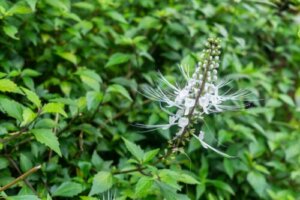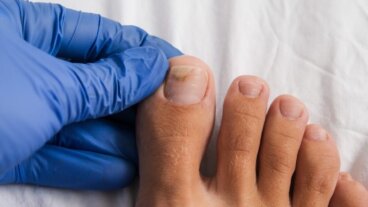Orthosiphon: Properties and Contraindications


Reviewed and approved by the pharmacist Franciele Rohor de Souza
Orthosiphon, also known as cat’s whiskers, is a herbaceous plant with the scientific name Orthosiphon aristatus. It usually grows in the soils of southern China, Southeast Asia, and Australia. However, it has also been introduced in some regions of Central and northern South America. It belongs to the family labiatae or lamiaceae, of which basil is also a member.
In its countries of origin, this species is used for ornamental purposes, due to its striking white flowers. It’s also used in the form of tea or extracts for various medicinal purposes. In this article, we’ll you what its main applications are, what the evidence says, and information about its contraindications.
Uses and properties of orthosiphon
Often, orthosiphon leaves are used for the preparation of infusions. In fact, it’s known on the market as Java tea. It’s important to note that other parts of the plant have toxic components and aren’t edible.
However, evidence on the safety and efficacy of this plant is still limited. Because of this, it isn’t a first-choice treatment and should be used with caution. Let’s take a look at its most common uses.
You may be interested in: Medicinal Herbs to Cleanse Your Liver
Diuretic
As mentioned in a review article reported in the Journal of Medicinal Food, orthosiphon has diuretic properties that are used to stimulate the elimination of fluids and fight inflammation. In particular, substances known as sinensetin and tetra methoxy-flavones would be responsible for this effect.
Bladder problems
Due to its ability to stimulate the flow of urine, extracts of this plant are believed to promote bladder cleansing. In fact, it’s a popular remedy for conditions such as cystitis. In a study on mice reported in Phytomedicine, orthosiphon was useful in fighting an infection of the bladder and urinary system.

Diabetes
Java tea isn’t a first-line treatment for diabetes. However, evidence suggests that it may have a hypoglycemic effect that helps to reduce high glucose levels. It is important to use it sparingly, as a preventive measure only. If you are taking medication for diabetes, it’s best to avoid taking it.
Weight loss
In folk medicine, orthosiphon is considered a “fat-burning” ingredient. However, to date, there are no studies or scientific references to support this effect. On the contrary, it has been made clear that tea from the plant doesn’t burn stored fat reserves. Still, it appears to be an ideal weight loss supplement.
An ethanolic extract of the leaves was reported by Planta Medica to help reduce body weight gain. It was even helpful in lowering high cholesterol and triglyceride levels. Despite these results, more research is needed.
For now, the plant’s slimming effects are explained by its diuretic qualities. By stimulating the elimination of liquids, it also helps to reduce kilos. However, this only occurs when it is included in the framework of a healthy diet and a physical exercise plan.
Other possible benefits of orthosiphon
Traditionally, this plant has also been given other medicinal applications. However, it should be borne in mind that these are uses that haven’t been sufficiently investigated. They cover the following:
- Respiratory diseases
- Nervous system disorders
- Fungal infections
- Arthrosis, arthritis, and gout
- Skin disorders
- Arterial hypertension
- Gallstones
Orthosiphon side effects and contraindications
Java tea is considered safe when consumed orally, and moderately, for up to 8 weeks. However, some people may experience the following side effects:
- Stomach discomfort
- Nausea and vomiting
- Dizziness
Also, we should point out that the plant and its derivatives are contraindicated in the following cases:
- Pregnancy and lactation
- Renal insufficiency
- Chronic heart disease
- Dyspepsia
- In children
- People taking medication
On the last point, it’s essential to be aware that it can cause interactions if consumed simultaneously with drugs for diabetes, antihypertensives, lithium, or diuretic drugs, among others. It’s best to consult your doctor or pharmacist.

Another great article for you: The 4 Most Diuretic Infusions
Dosage and presentations
The dosage of orthosiphon depends on factors such as age, health status, and the purpose of use. At the moment, there are no exact guidelines that can determine precisely how it should be consumed. Because of this, it’s important to read the label of the supplement and follow its indications.
The capsule presentations can be taken in quantities of 2 to 3 per day. As for the extract, 30 to 50 drops are suggested. If you prefer to ingest it in tea, then opt for the following recipe.
Ingredients
- 1 tablespoon of orthosiphon leaves (10 grams)
- 1 cup of water (250 milliliters)
Preparation
- Pour the leaves of the plant into a cup of boiling water
- Cover the drink and let it steep for 10 minutes
- Consume 1 cup per day
What should you remember about orthosiphon?
Orthosiphon extract and tea are used as an adjuvant to stimulate the elimination of retained fluids. In addition, it’s thought to promote weight loss and alleviate certain health problems. However, evidence for its safety and efficacy remains insufficient. Therefore, it should be used with caution, and only on an ad hoc basis.
All cited sources were thoroughly reviewed by our team to ensure their quality, reliability, currency, and validity. The bibliography of this article was considered reliable and of academic or scientific accuracy.
- Ameer OZ, Salman IM, Asmawi MZ, Ibraheem ZO, Yam MF. Orthosiphon stamineus: traditional uses, phytochemistry, pharmacology, and toxicology. J Med Food. 2012 Aug;15(8):678-90. doi: 10.1089/jmf.2011.1973. Epub 2012 Jun 25. PMID: 22846075.
- Sarshar S, Brandt S, Asadi Karam MR, Habibi M, Bouzari S, Lechtenberg M, Dobrindt U, Qin X, Goycoolea FM, Hensel A. Aqueous extract from Orthosiphon stamineus leaves prevents bladder and kidney infection in mice. Phytomedicine. 2017 May 15;28:1-9. doi: 10.1016/j.phymed.2017.02.009. Epub 2017 Feb 28. PMID: 28478807.
- Lokman EF, Saparuddin F, Muhammad H, Omar MH, Zulkapli A. Orthosiphon stamineus as a potential antidiabetic drug in maternal hyperglycemia in streptozotocin-induced diabetic rats. Integr Med Res. 2019;8(3):173-179. doi:10.1016/j.imr.2019.05.006
-
Seyedan A, Alshawsh MA, Alshagga MA, Mohamed Z. Antiobesity and Lipid Lowering Effects of Orthosiphon stamineus in High-Fat Diet-Induced Obese Mice. Planta Med. 2017 May;83(8):684-692. doi: 10.1055/s-0042-121754. Epub 2016 Dec 19. PMID: 27992939.
- Chung YS, Choo BKM, Ahmed PK, Othman I, Shaikh MF. A Systematic Review of the Protective Actions of Cat’s Whiskers (Misai Kucing) on the Central Nervous System. Front Pharmacol. 2020;11:692. Published 2020 May 13. doi:10.3389/fphar.2020.00692
This text is provided for informational purposes only and does not replace consultation with a professional. If in doubt, consult your specialist.








